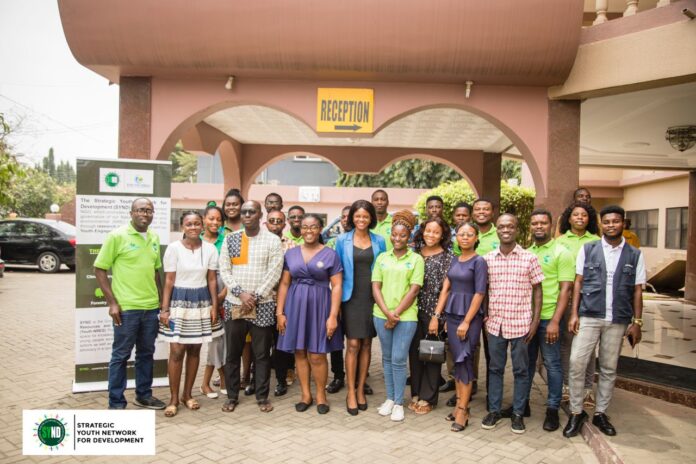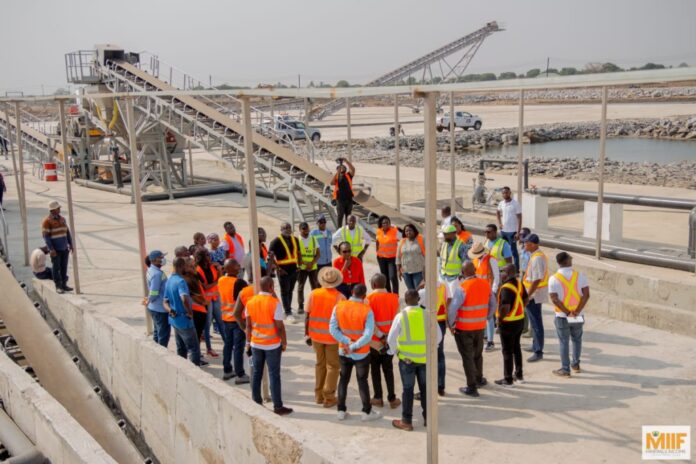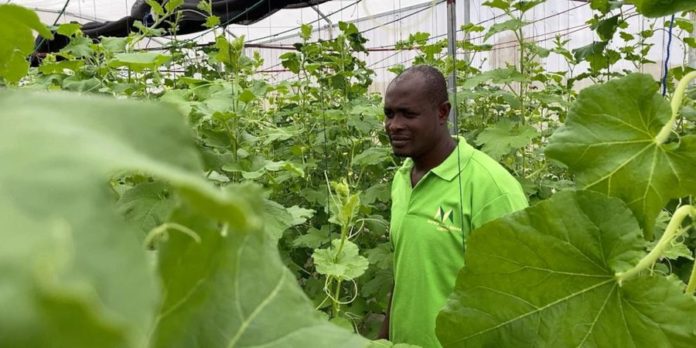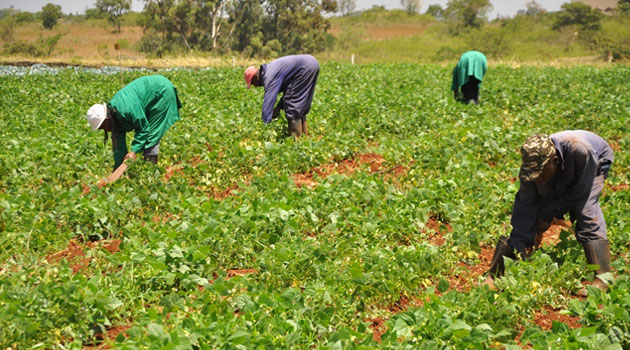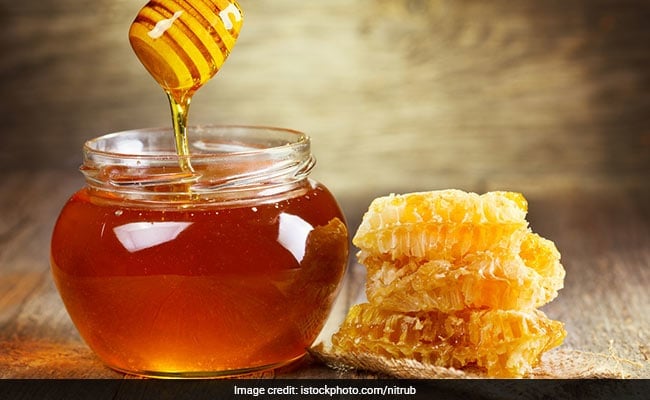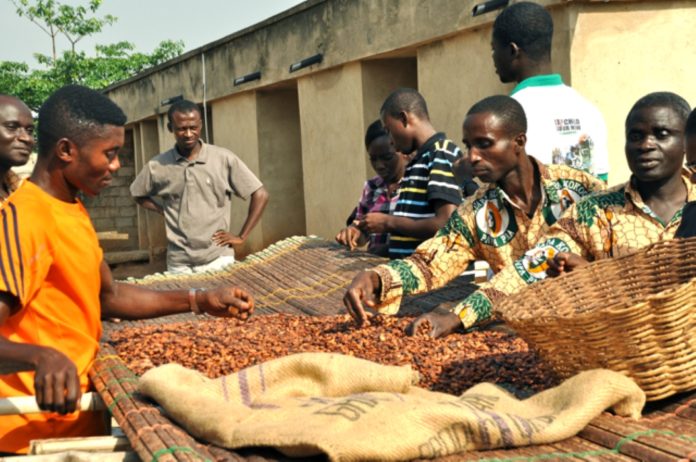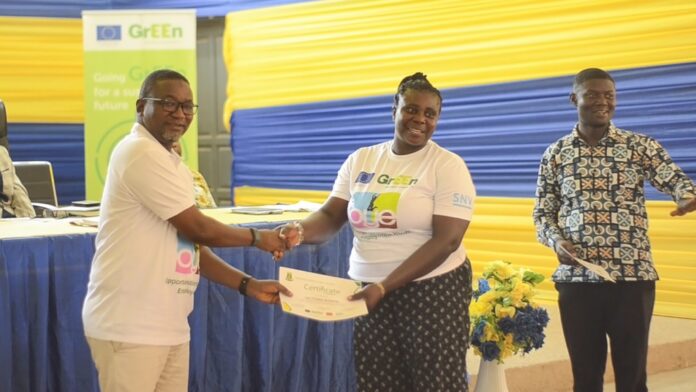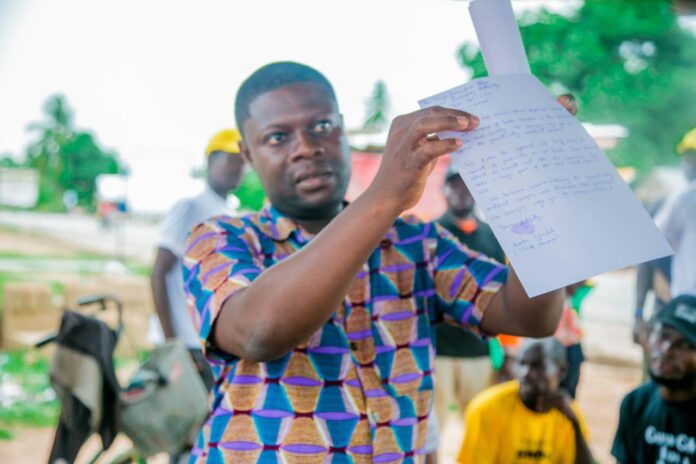As part of its efforts to help address climate change and problems of biodiversity in Ghana, Strategic Youth Network for Development a youth-oriented organisation has organized a day training to explain the “Banks and Biodiversity No Go Policy” as the world grapples with the climate crisis.
MIIF mulls investment in Ada Songhor Salt project.
The Minerals Income and Investment Fund (MIIF) has revealed plans to support the development of the salt industry in Ghana with the Ada Songhor Lagoon as utmost priority.
This followed a working tour by the Board and Management of MIIF and officials of the Ghana Stock Exchange. The Ada Salt pans on the Songhor Lagoon have the potential to be the largest salt producing area in sub-Saharan Africa.
The CEO of MIIF revealed to reporters that, “MIIF is far advanced with plans to invest in the Ada Songhor salt project towards developing it to be the largest in sub-Saharan Africa. Ultimately this investment seeks to ensure that Ghana benefits from the many uses of salt, especially as a core input to support the industrialization agenda of the Government of Ghana”.
The Ada Songhor pans which sit on some 41,000 acres straddling at least thirty-three (33) Ada Communities is larger in acreage than Walvis Bay of Namibia which is about 16,700 acres and is the largest in sub-saharan Africa.
According to officials of Electrochem Ghana Limited which is the Ghanaian company developing the salt pans, the Songhor has the potential to produce more than 5 million MT at capacity with an estimated 650,000 metric tons (mt) of industrial salt in 2023 and circa 1.5 million MT over the next five years with a 99.99% purity.
MIIF’s Salt outlook and Investment.
MIIF has declared salt as a priority mineral in Ghana in line with its investment strategy of generating downstream to upstream value from every single mineral.
According to Professor Douglas Boateng, the Board Chairman of MIIF, “the Fund is targeting investments across the producing areas in the Greater Accra and Central regions of Ghana”.
The CEO of MIIF, Mr. Koranteng further stressed that “Salt is an infinite resource with over 14,000 uses. At full potential and with such expansive usage, salt in Ghana has the potential to earn circa $500 Million a year in foreign exchange with Nigeria and the sub-region as priority markets.
Salt as a raw material covers the pharmaceuticals, food processing, oil and gas, food preservation, production of caustic soda, the textiles industry, mining, road maintenance, hospitals and hospitality sectors which all require high grade salt to support the manufacturing of inputs or processing.
This is the reason why MIIF is excited about this opportunity for Ghana and is currently working on a broad based investment which would include a listing of the project on the Ghana Stock Exchange”.
The scale of the Ada Songhor salt project also presents opportunities for two export jetties to facilitate export and other lake transport opportunities, create massive employment in the producing areas and substantially revitalize the local economies.
MIIF Investment and the intended Listing of Electrochem on the Ghana Stock Exchange
In accordance with MIIF’s investment strategy to ensure that all major investments are listed on the Ghana Stock Exchange, the Chief Executive Officer of MIIF, Edward Nana Yaw Koranteng confirmed that Electrochem has agreed to list on the Ghana Stock Exchange as a condition for MIIF’s investment.
Mr. Koranteng stated that, “Investing in salt is part of our mineral diversification strategy in line with President Nana Akufo-Addo’s charge to MIIF, to ensure that we create Ghanaian business champions while at the same time creating opportunities along the value chain and on the capital markets for Ghanaians to directly have the chance to invest in such companies”.
The Managing Director of the Ghana Stock Exchange Ms. Abena Amoah who is also a member of the Investment Advisory Committee (IAC) of MIIF said; “What I have come to see here, really warms my heart. A great company is underpinned by the quality of the asset. We can become Africa’s number one salt producer, the sea never dries, the technology exists to mine the salt, the market for salt is not in doubt and with some ringfencing and great risk management, the investment in Electrochem and its listing on the Ghana Stock Exchange will be a win-win for all Ghanaians.”
About Ada Songhor
Constructed in the 1970s, the Ada Songhor Salt Project by acreage is the largest in sub-saharan Africa. It has run into several challenges over the years including lack of investment and was vested in the Government in 1992.
Following a five-year investment endeavour which required garnering and courting community support, Electrochem Ghana Ltd finally obtained a long term lease in 2021 to manage the salt pans and to quickly put a plan of development in place.
The plan has seen a total investment of $80 Million so far which has gone into rehabilitating the pans which had become decrepit and overly silted and the restoration of the Songhor Lagoon which had dried up for eight years.“All the work done from scratch has been with our technical partners, Serra Process of Spain.
Their advice and expertise gleaned from years of experience as a major global player in Salt is responsible for the successes chalked on this project” says Dzigbordi Kwaku-Dosoo, the Business Consultant on the project for Electrochem. “We are excited about the Ada Songhor project because it has restored the balance between the business and ecology of the area.
As a Ramsar site (wetland reserved for international environmental purposes), the birds have started coming from all over the world and on the economic front, more than 1500 young people have been employed on the mine, through a micro-credit facility developed by Electrochem, the women in the various communities have interest free loans for their businesses and fishing is back in full force on the lake,” Dzigbordi Kwaku-Dosoo said.
The current status of the Ada Songhor Salt Project
Electrochem has outlined four major steps for the development of the Salt pans in Ada. The First is the restoration of the lake and the pans which have been completed.
The expansion of infrastructure and importation of evaporators are ongoing with the company currently at circa 12% production.
The construction of an industrial bay to support the logistics management and export which has been completed. This is now the largest in Africa.
The firm plans to also build a jetty to facilitate sea exports and has already obtained the permits for the project. Further to the above, Electrochem plans to construct a refinery to support the production of domestic consumption of salt or retail use.
The Chairman of Electrochem, Daniel Mckorley said “We have invested our toil into this project but we recognize that we still have someway to go. We are going to be Africa’s number one producer of Salt both for industrial and domestic use. Our plan is to make the activities of Songhor Salt benefit the people of Ada and the people of Ghana. My philosophy is simple. If we cannot use the minerals God has given us to make our people wealthy, then we would have failed God completely”.
About MIIF
The Minerals Income Investment Fund (MIIF) is Ghana’s minerals sovereign fund. MIIF was established pursuant to the Minerals Income Investment Fund Act, 2018 (Act 978) as amended to receive royalties’ payments from mineral production activities in Ghana and to manage Government of Ghana’s equity interest in mining companies
Shortage of vegetables and fruits in the UK is an advantage to Ghanaian farmers – Anthony Morrison.
On February 25, 2023, Guardian reported that certain commodities key including which is included tomatoes are hard to come by in UK supermarkets due to poor weather reducing the harvest in Europe and North Africa.
Ghanaian farmers abandon Russian – Ukrainian fertilizer.
Ghanaian agronomists report farmers in the West African nation have switched to growing crops that do not require imported fertilizers after prices skyrocketed resulting from the war in Ukraine.
Agronomists in the West African nation reported that they recorded a 60 percent decline in fertilizer imports and a surge in prices resulting from the war in Ukraine and western-led sanctions on Russian companies.
Felix Kamassah, a Ghanaian vegetable farmer said the increased costs have pushed him and his peers into producing crops that require less inputs.
“We have to look at other alternatives to make sure that we are in business because (as) commercial farmers, when we want to rely on fertilizer importation, for now you can’t make any good profit out of it because it’s a big challenge,” said Kamassah.
Nana-Aisha Mohammed, the manager for the African Fertilizer and Agribusiness Partnership in Ghana, said global prices for inputs have stabilized but it will take approximately six months before retails prices follow suit.
“The dynamics of fertilizer crisis in Ghana have slightly changed. Globally, the prices are stabilizing. However, it will take about six months for retail prices to catch up,” said Mohammed.
“This is largely due to logistics and supply chain issues… we also as a country are facing some economic challenges, which means that our currency is not very stable and it’s performing very poorly against the trading currency which is the dollar,” he added.
Fiifi Boafo, the spokesperson for Ghana’s Cocoa Board said farmers can use chicken manure as an alternative. “In terms of quality it is even better for us to rely on the poultry manure than the inorganic fertilizer that we import because that is natural,” said Boafo.
“It has shown that it rather builds a soil structure better than the inorganic fertilizers we import. The only challenge, however, is that coming by it is a bit more difficult compared to accessing the inorganic from the market,” he added.
$32.53m launched at the North to boost agriculture production.
A project aimed at boosting food production and addressing key constraints in the agriculture value chain in Northern Ghana has been launched in Tamale.
Dubbed “Savannah Agricultural Value Chain Development Programme (SADEP), the project is expected to contribute to the government’s industrialisation agenda, support Planting for Food and Jobs (PFJ), Rearing for Food and Jobs (RFJ), skills development and entrepreneurship for women and youth, and build resilient food systems in the north.
The five-year project is being initiated by the Savannah Agricultural Improvement Programme (SAPIP) in collaboration with the Ministry of Food and Agriculture with a $32.53 million grant from the Africa Development Bank (AfDB) and the government of Ghana.
The project interventions would include producing over 8,000 of crops, 50,000 guinea fowls, 50,000 broilers, and 50,000 layers as initial input for commercial poultry production, in accordance with the government subsidy policy.
At least, 5,000 women-headed households in vulnerable communities would be supported with 50,000 guinea fowls with each household receiving 10 birds for rearing to enhance farm income and household nutrition.
Overview
Giving the overview of the project at the launch in Tamale last Tuesday, the National Project Coordinator of SAPIP, Felix Dramani, said the project sought to build on successes under the SAPIP and Savannah Investment Programme (SIP) that had so far expanded the production of maize and soybean from 80 hectares in 2018 to 14,000 hectares in 2021.
“Inputs such as fertilisers and seeds will be provided to commercial farmers and their out-growers to boost local production of rice, soybean and maize,” he said.
Mr Dramani added that 20,000 jobs would be created under the project and it was expected that 40 per cent of those jobs would go to women and the youth.
He stated that it would be implemented in nine districts in the five regions of the north and would go a long way to address key constraints in food security and the poultry and livestock feed industry.
Commendation
For his part, the deputy Minister of Food and Agriculture in charge of Crops, Yaw Frimpong Addo, lauded the AfDB for the continued support which was transforming the agricultural sector and the lives of the people.
He said the overall objective of the SEDAP project was to ensure national climate-resilient food and nutrition security, create employment and contribute to industrialisation.
Global crises.
The Country Manager of AfDB, Eyerusalem Fasika, said the project was designed to help the government mitigate the impact of the COVID-19 pandemic and the Russian/Ukraine war.
“We believe that prioritising key agricultural value chains in different agro-ecological zones of Ghana will create the platform and support needed to catalyse investment, and unlock Ghana’s potential for transformation,” she said.
The country manager added that the country had the technologies, private sector and the youth to achieve food sovereignty and develop innovative flagships to make sure that stakeholders, especially smallholder entrepreneurs, women and youth were not left behind.
Ms Fasika reiterated her outfit’s commitment to continue to support the agricultural sector to help ensure food security.
The 15 best honey producing countries in the world: see Ghana’s position.
The honey industry involves the production and sale of honey, as well as other bee-derived products such as beeswax, propolis, and royal jelly.
The industry has been growing in recent years due to the increasing demand for natural sweeteners and the health benefits associated with honey.
Fortune Business Insights has forecasted the worldwide honey industry to increase at a CAGR of 5.83% from $8.53 billion in 2022 to $12.69 billion by 2029.
1. TURKEY
Centauri Honey: $11,000/kg
Turkey is home to some of the most expensive honey varieties in the world. These include Elvish honey, which is obtained from deep caves, and Centauri honey, which is cultivated at an altitude of 2,500 meters above sea level.
Centauri Honey is the world’s most expensive honey due to its rarity as it is only harvested once a year.
The bee colony is kept away from human residences and other colonies to ensure its purity and safety, and only natural herbs and plants are used to deter parasites. It is only harvested once per year to ensure that there is enough honey to sustain bees.
2. NEW ZEALAND
New Zealand32+ UMF Limited Reserve Manuka Honey: $5,200/KG.
New Zealand produces a large variety of honey, each with its distinct taste, hue, quality, and benefits.
The country is able to produce many famous honey varieties, including kamahi honey, beechwood honeydew, and manuka honey, due to the diversity of its natural flowers and pollination.
Some of the top honey brands in New Zealand include New Zealand Honey Co., Steens, Comvita Limited, Oha Honey LP, and Streamland Biological Technology Ltd.
Manuka honey is the most famous honey variety from New Zealand, and it is made from the nectar of manuka tree flowers, native to isolated regions of the country, which only blooms for two to six weeks a year.
Comvita Limited (OTC:CVNZF) is a New Zealand-based company that specializes in producing and selling manuka honey.
3. YEMEN
Sidr Honey: $1000/kg
The honey from Yemen is regarded as one of the finest honey in the world. Among several high-quality honey varieties, Royal Sidr Honey takes the crown as the best honey from Yemen. It is made from the wild Sidr tree’s blooms, which are found in Yemen’s uncultivated desert regions.
Sidr honey is only harvested in winter through manual labor using simple tools, smoke, and sharp knives. Sidr trees found in Yemen are of the highest quality as they grow naturally without any pesticides, chemicals, or fertilizers.
The honey’s exceptional quality, therapeutic value, and transportation challenges all contribute to its price. Other Yemeni varieties include doani honey, al-osaimi honey, samar honey, and al-marai honey.
4. MALAYSIA
Tualang Black Honey: $500/kg
Malaysia boasts one of the most biodiverse flora, with over 15,000 species of vascular plants. The honey varieties such as Kelulut, Acacia, and Tualang produced in Malaysia are known to have amazing health benefits.
Several pure honey brands, such as Capilano Pure Honey, Country Farm Organics Honey, CED Pure Honey, and LOHAS Premium Raw Honey, operate in Malaysia.
The Tualang Black Honey is among the most expensive honey varieties due to its health benefits and difficulty of obtaining it.
The honey is gathered from combs on the towering Tualang trees because the bees are fiercely defensive and cannot be tamed.
5. ISRAEL.
Life Mel Honey: $453.5/kg
Israel is aptly called the land of milk and honey because of the country’s rich history of cultivating honey. The most sought-after honey in Israel is made from Mount Hermon’s blossoms.
Beekeepers require special military authorization to gather it as it is one of the last remaining wilderness areas of the country untouched by any industrial crops.
Life Mel Honey from Israel is among the top honey varieties in the world.
The honey bees are fed on a special food mixture which causes the honey to develop a unique taste and the therapeutic benefits of natural ingredients and herbs used in the feed.
6. GREECE
Golden Thyme Honey From Ikaria: $250/kg
Greece has an advantage over other European honey producers in terms of quality since the majority of its honey originates from uncultivated environments that are devoid of chemicals such as pesticides and fertilizers.
Some of the popular varieties of Greek honey include thyme honey, pine honey, citrus honey, fir honey, and heather honey.
The golden thyme honey from Ikaria is considered one of the most expensive honey because the bees in Ikaria exclusively gather nectar from medicinal herbs, pines, and other local flora.
The quantity of this honey is also limited because the Ikarian people still use the same harvesting method they did decades ago, which also keeps the quality of honey unchanged.
7. THAILAND
Stingless Bee Honey: $216/kg
Even though Thailand is a relatively small supplier in the honey market, Thai honey is in demand due to its purity and quality.
Among all the varieties, the Stingless Bee Honey is among the most valuable honey variety in the country.
The high price of this honey is due to its therapeutic and psycho-chemical aspects. It has natural hydrating, anti-inflammatory, antioxidant, and antibacterial qualities that promote wound healing.
Another factor that draws a lot of customers is the honey’s high concentration of flavonoids and polyphenols in comparison to other honey varieties.
8. ETHIOPIA
White Honey from Tigray Mountains: $215.9/kg
Ethiopia is the biggest natural honey-producing nation in Africa. It is home to roughly 10 million wild colonies and about 6 million controlled bee colonies.
The most distinctive type of honey in Ethiopia is the White Honey from Tigray Mountains, which has a particular flavor and color thanks to a variety of native plants that thrive there.
The Tigray White honey is also expensive since it is produced in limited quantities, and the bees must go far distances for pollination because of the drought in the Tigray mountain region.
Ethiopia also produces other famous honey varieties such as wenchi volcano honey, wolisso honey, shalala honey, and horde honey.
9. RUSSIA
Bashkirian Honey: $130-220/kg
Russia is among the top honey producers in the world.
The country produces a large variety of honey, including buckwheat honey, lime honey, broom-heather honey, and chestnut honey.
The Bashkirian honey is the rarest and most expensive honey variety produced in Russia because it is produced at a high-altitude zone free of pollution and is only harvested once every year.
Honey bees combine nectars from many plants, including a significant share of linden nectar, to create Bashkirian honey, giving it a distinctive flavor.
10. SPAIN
Miel Lo Mejor del Bierz: $162/kg
Spain is among the leading European honey-producing countries. Several monofloral honey varieties are found in Spain, including orange blossom, rosemary, eucalyptus, thyme, and chestnut.
The honey from the El Bierzo district in Spain is considered the most expensive honey in Europe because a huge amount of work is required to produce it.
Honey bees have to travel almost 7,000 km to collect nectars from almost 200,000 to 250,000 flowers just to produce 1 kg of Miel Lo Mejor del Bierz honey.
The honey variety is also famous throughout the Arab world because of its halal certification.
11. FRANCE
Opéra Garnier Honey: $129.6/kg
France is an excellent feeding ground for bees, and all 22 of its regions produce honey. Numerous honey varieties are produced throughout the nation, including Miel des Cévennes, Miel de Sapin des Vosges, Miel de Corse, Miel d’Alsace, and Miel de Provence.
The honey from Opéra Garnier is the most valuable as it is extracted from the roofs of Opéra Garnier, which is one of the most celebrated monuments in Paris, giving this honey variety a unique and symbolic background.
Another reason why Opéra Garnier honey is among the most expensive varieties is its limited annual supply of 500 Kg.
12. NEPAL
Himalayan Honey: $120.5/kg
Beekeeping is practiced by more than 50,000 households in Nepal. The country has both multi-floral and uni-floral honey due to its diverse flora.
There are also some unique honey varieties emanating from Nepal from fruit trees, such as citrus, wild cherry, and lychee.
Among all the varieties, Himalayan honey is the most valuable due to its rarity and difficulty of obtaining it.
The honey hunters of Gurung tribes climb 200-300 meters by hand-made rope ladders to harvest honey twice a year.
It is produced by Himalayan giant bees that gather nectar from delicate rhododendron and wildflower petals, giving the honey psychedelic properties.
13. AUSTRALIA
Manuka Honey MGO 100+: $107.9/kg
In Australia, honey bees may visit over 700 native blooming plants to gather nectar and pollen to make honey.
The country is home to several famous honey varieties, including jarrah, banksia, leatherwood, mallee, and karri honey. Among all the varieties, manuka honey is the most expensive and is known for its health benefits and purity.
The price of manuka honey varies depending on its MGO rating. Australia’s most famous honey brands include Beechworth, Capilano, Aldi Bramwells, Woolworths, and Coles.
Capilano Honey Limited (CZZ.AX) is an example of an Australian company that produces and sells honey and other bee-related products.
14. MEXICO
Avocado Honey: $63.45/kg
Mexico is one of the biggest honey exporters in the world. Mexican avocado honey is one of the rarest honey varieties in the world.
It is produced by bees feeding on avocado trees growing in the world’s largest and oldest avocado plantation, which is located 5000 ft above sea level in the Michoacan highlands of Western Mexico.
The avocado honey provides immunity from pollen allergies of avocado and other flowers found within the region. It is also beneficial for the skin if used as a skin mask.
15. United StatesTupelo Honey: $61.72/kgThe United States produced a total of 126 million pounds of honey in 2021.
The country produces well-known honey varieties, including kiawe honey, eucalyptus honey, mountain wildflower honey, buckwheat honey, spring blossom chunk honey, and tupelo honey.
Tupelo honey is the most expensive variety because of its rarity, as the Apalachicola River Basin, Florida, is the only place where tupelo trees may grow in large stands.
The high ORAC (Oxygen Radical Absorbance Capacity) rating is among its many advantages, which indicates that it has the amazing ability to shield the skin from damage caused by the sun and other environmental irritants.
The United States is home to some of the biggest honey brands in the world, such as Barkman Honey LLC, Beeyond the Hive, and Dutch Gold Honey Inc. Archer-Daniels-Midland Company (NYSE:ADM) is a US-based multinational food processing and commodities trading corporation that produces and markets honey products.
Extend cocoa pension scheme to all farmers.
Member of Parliament (MP) for Offinso South in the Ashanti Region, Dr Isaac Yaw Opoku, has urged the government to extend the Cocoa Farmers’ Pension Scheme to cover all farmers in cocoa growing regions across the country to motivate them to “stick to” cocoa farming.
He said extending the scheme, which was piloted in the Western North and the Ashanti regions, would encourage farmers to stop ceding their cocoa farms to other competing land uses, particularly illegal mining and rubber cultivation.
“This will also help our cherished cocoa farmers to enjoy decent and sustainable pension when they retire from active cocoa farming,” he stated.
Dr Opoku made the call when he presented a statement to mark the National Chocolate Day in Parliament yesterday.
This year’s celebration was held on the theme, “Eat chocolate, stay healthy and grow Ghana”.
Cocoa productionDr Opoku said as Ghanaians celebrated the national chocolate day, they must not lose sight of the factors which militated against cocoa production in Ghana.
He said in the 2020/2021 cocoa season, production in Ghana stood at 1,045,500 metric tonnes, the highest production ever in Ghana’s history.
Surprisingly however, he said one year on, production had dropped to 683,268.9 metric tonnes in the 2021/2022 season, representing 34.6 per cent decline.
That, he said, was the lowest production in the country since the 2009/2010 season.
“Mr Speaker, although several factors may account for the sharp decline, principal among them is the effect of illegal mining, popularly referred to as ‘galamsey’.
“Mr Speaker, if the rate of destruction of cocoa farms as a result of galamsey activities is allowed to continue, in no time, our enviable position as the second largest producer of quality premium cocoa in the world will be lost and there will be very little to celebrate in the future,” he said.
Quality beansThe MP indicated that to ensure availability of adequate quality cocoa beans for local processing and export, farmers must be encouraged to adopt the productivity enhancement programmes introduced by the Ghana Cocoa Board in 2017.
He also emphasised the need for soil moisture stress in cocoa farms as a result of climate change to also be addressed.
“Ghana Cocoa Board must endeavour to extend the pilot irrigation programme started in 2017 to cover many more medium and large-scale farmers.
“Mr Speaker, the Cocoa Research Institute of Ghana must also intensify ongoing research in the development of drought resistant or tolerant cocoa varieties that suit the marginal cocoa growing areas of Ghana,” the MP added.
Dr Opoku told the House that for Ghana to make gains in its cocoa crop, efforts must be made to support the sustainable production of cocoa and local processing of cocoa beans.
“Let us patronise made-in-Ghana chocolate and cocoa products and let us say no to the destruction of cocoa farms for galamsey activities and the pollution of our water bodies which serve as sources of water for irrigation of our cocoa farms,” he added.
EU funded 114 graduates from SNV, Kwadaso Agric College.
Under a three-phase pilot, a total of 114 agriculture entrepreneurs have undergone a 4- week of intensive and practical training targeted at youth in the Ashanti and Western regions of Ghana.
The four year SNV-GrEEn project with the United Nations Capital Development Fund is funded by the European Union Emergency Trust Fund (EUTF) for Africa and the Embassy of the Kingdom of the Netherlands.
The training was targeted at strengthening Agri-business.
In supporting skills development, SNV Ghana through its GrEEn Project, partnered with the Kwadaso Agricultural College and the Ghana Education Service to train and award a national General Agriculture certificate to entrepreneurs in the agriculture value chain.
Vice Principal of the Kwaadaso Agric College, Dr. Isaq Shaibu underscored the significance of such initiatives.
The skills development adviser of SNV Ghana, Dorcas Hammond says the programme is to nurture the skills of participants in Agriculture development.
Participants who benefitted from the programme said, it will help contribute to the growth of their farm works.
Be serious about agriculture investment for economic recovery – Dr. Ojadah told Africans.
With Africa holding the world’s largest arable lands, Africans are being urged to restore their passion for agriculture.
This is because it is the next sustainable sector to revive their economy particularly at a time when global shocks are badly impacting their economies.
The acting Global President for the International Peace and Governance Council (IPHC), Dr Jonathan Ojadah, said the exposure to the oil boom has pushed some countries to deviate from agriculture such that the practice of subsistence agriculture, which used to be a source of livelihood for many, has stopped.
Dr Ojadah made the call last Friday in an interview with the media at the 11th Pan African Leadership, Investment Summit and Honours in Accra.
Organised by IPHC-Ghana in collaboration with the Ministry of Tourism, Creative Arts and Culture, the summit brought together Africa investors to discuss various investment opportunities on the continent.
It was on the theme: “Peaceful Coexistence and Synergy for African Development”.
“Most countries are still undergoing recession so we deem it necessary that we advise every country to take their agricultural investment opportunities seriously because we believe that with food security, hunger will be eradicated.
When hunger is eradicated we can achieve sustainable peace and it is on the back of sustainable peace that investment promotion can survive,” he said.
He said his outfit has embarked on a sustainable agricultural project which he believes will create a lot of good security for the populace.
“We at UNIPGC are partnering the United Nations Association of Ghana to implement the zero hunger agenda of the Sustainable Development Goal (SDG) of the UN to project the role of agriculture in sustaining the economy towards national development,” he added.
Ensuring sustainable development
In a speech read on his behalf, the Minister of Tourism, Arts and Culture, Dr Ibrahim Awal, said:
“Africa has so much resources but benefits from just a little, therefore, it’s time to seek the opinions of the traditional authorities, religious leaders and civil society organisations to ensure inclusive and sustainable development.
In this vein, with the multi-party democracy that most African countries have chosen, it’s imperative to harness its potential for peace and development on the continent.”
Food Insecurity: Playing Politics with Ghana’s Agriculture Industry – Nana Yaw Reuben Jr writes
The term Agriculture is derived from two Latin words ager or agri meaning soil and cultura or Cultus meaning cultivation. Agriculture is the science of cultivating the soil, harvesting crops, and raising livestock and also the science or art of the production of plants and animals useful to man and in varying degrees the preparation of such products for man’s use.

